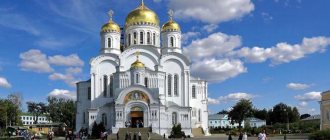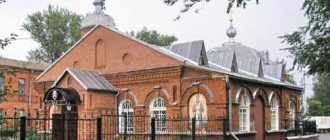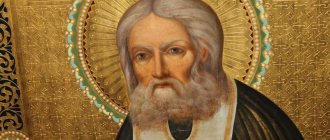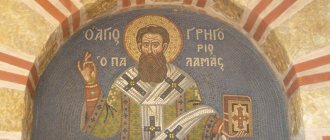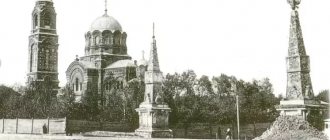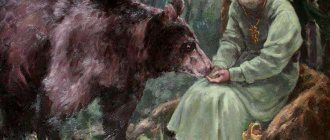In that miraculous place where the relics of Seraphim of Sarov are located, believing parishioners find peace and hope for well-being. The remains of the saint perform the same miracles that the saint himself performed during his lifetime. Today, an Orthodox person can pray to the relics of Seraphim in the Sarov Monastery, built in the Nizhny Novgorod region.
Discovery of the relics of St. Seraphim of Sarov
Brief biography of the monk
The name of this saint is glorified throughout the Orthodox world. It was published in mid-July 1759 in Kursk.
- In 1786, Seraphim became a monk and swore eternal allegiance to the Almighty Father. He spent six years in daily prayers, often forgetting about sleep and food.
- When Seraphim turned 39, he was ordained to the honorary rank of hieromonk. A year later he left the monastery and prayed in solitude to God for the salvation of lost souls.
- In 1807, the monk took a vow of silence and tried not to enter into dialogue with anyone. He performed such asceticism for ten years, after which he returned from solitude to his native monastery.
- The holy elder left the mortal world in 1833, being in a prayerful pose in front of the lectern.
Read about the saint:
- Feast of Seraphim of Sarov August 1
- Seraphim-Sarov Monastery in the Voronezh region
- Icon of St. Seraphim of Sarov
The relics of Seraphim of Sarov stood in the temple for more than a week, but did not emit the slightest smell of rotting. After the funeral ritual, the saint’s body was interred next to the cathedral; it remained here for 70 years, until 1903.
On a note! The monk instructed: the more often you receive communion in front of holy images, the closer you become to salvation. Even the most inveterate person in sins will gradually get rid of the darkness of ignorance and atone for all vices if he begins to pray to the Lord every day for the gift of healing.
On the authenticity of the relics of St. Seraphim of Sarov
TIME TO GIVE ANSWERSThere is plenty of evidence that the relics of St. Seraphim of Sarov, discovered by the Bolsheviks on December 17, 1920, were secretly replaced earlier with the remains of another Sarov hieromonk. And after the closing of the relics, which took place on August 16, 1921, they were again placed in their coffin. And the relics of the substitute, in the very form in which they lay in the saint’s shrine, were returned to their original place.
And after the disappearance of the relics of Father Seraphim, taken to Moscow in 1927, they were discovered by employees of the Krasnoslobodsk OGPU and transported to the Leningrad Museum of Religion and Atheism. Where they were found in 1990 and transferred to Diveevo in 1991 as the “authentic” relics of Seraphim of Sarov.
For a better understanding of the events of all those years, we cite the words of His Holiness Patriarch of Moscow and All Rus' Alexy II:
“In 1920, in the city of Temnikov (this is a mistake, not in Temnikov, but in Sarov - ed.) in the Tambov province, atheists performed an autopsy of the holy relics of St. Seraphim. The report drawn up during the autopsy described in great detail both the relics themselves and what they were dressed in and on what they rested...
During the inventory carried out in connection with the decision to return the Kazan Cathedral to the Russian Orthodox Church and the departure of the museum from it, holy relics were found. Sewn into matting, they lay in the museum's storerooms, in one of the rooms of the former sacristy, where the tapestries were kept. When they unrolled the mat, they saw the relics, mittens put on their hands, on one of which was embroidered “Reverend Father Seraphim,” and on the other, “Pray to God for us.” It was impossible to claim that these were the relics of the Sarov wonderworker, based only on this inscription. Therefore, we found the act and documents of the opening of the relics in 1920.
One of these documents states that the relics were removed from the monastery for their destruction or exhibition in a museum. That is, the threat of destruction of the holy relics of St. Seraphim was quite real. But by the Providence of God, evil was turned into good, and everything worked out in such a way that a document was drawn up by the hands of atheists, describing in great detail the relics of the saint after their opening in the twentieth year.
A special commission found that the relics found in the Kazan Cathedral fully corresponded to the description of the relics of St. Seraphim of Sarov." (“Moscow Church Bulletin”, 1991, No. 14(59)).
But why can’t we recognize them as the authentic relics of St. Seraphim of Sarov?
1. On the relics located in Diveevo, there are completely no traces of tannins from being in an oak coffin filled with water for forty years. There is evidence of this in the memoirs of Archpriest Dimitry Troitsky, a participant in the 1903 celebrations: “Father Seraphim lay in a coffin on oak shavings. The entire contents of the coffin, due to the tanning properties of the shavings, and the most honest remains, and the gray hair on the head, beard and mustache, and all the monk’s attire - underwear, a linen cassock, a mantle, an epitrachelion and a cockle - everything was painted in one color, reminiscent of the crust of black rye of bread". (Archpriest Demetrius Troitsky. “Glorification of St. Seraphim of Sarov.” Library of St. Seraphim of Sarov).
If any of the readers have seen this color, they will say that it is dark brown.
This is confirmed by another piece of evidence from that time: “For application, a hole was left on the forehead, through which the dark brown part of the forehead is visible.” (V.P. Schneider. “To Father Seraphim. Memoirs of pilgrims.” Sarov celebrations).
These traces are not present on today's relics and their color is approximately two times lighter than that of the saint's relics in 1903, which is especially clearly visible from the particles of relics in new and pre-revolutionary reliquaries!
2. Evidence of their substitution is also provided by the act of closing the relics dated August 16, 1921, according to which their color became “...darker than it was during the opening on December 17, 1920.” (S. Fomin. “On a visit to Father Seraphim.” Documents on the opening of the relics).
That is, having just been taken out of the grave, they could actually darken in the light and fresh air. But how can relics with the color of “crust of black rye bread” noticeably darken?!
3. Proof of their substitution is the “act of autopsy of the remains of Seraphim of Sarov dated December 17, 1921,” which clearly shows that the Sarov monks, who were in a hurry to replace them, clearly confused the location of individual bones, which, when the original relics were found in 1903, “were located in anatomical order... All the bones were wrapped in monastic robes... The leg bones were collected in special shoes, the hand bones - in gloves... Both were placed in their places...” (Letter of Archimandrite Sergius Tikhomirov dated July 18, 1903).
Now compare their location with the act of December 21, 1920:
“One of the cotton wool hands that is set aside is taken, the cotton wool is unrolled, in which the ulna and radius bones of a small person are found, and the same is true in the second hand. The cotton wool of the brush is unrolled. The hand bones include one tooth and one part of a vertebra. In total, the hand contains four metacarpal bones, five carpal bones, five large phalangeal bones, two second phalangeal bones, and two ulnar bones. This is all in the left hand, and among the carpal bones there is one bone of the other hand. The hand of the right hand is unfolded; among the bones of the hand there is part of a vertebra. In total there are 5 carpal bones, 4 metacarpal bones, 3 first phalangeal bones, three second phalangeal bones and 3 nail bones. Take the shoe and take it apart. The left shoe, among the bones of the foot there is a bone of the hand.(!)”. (Archive of the Moscow Bank of the MSSR. D. 29. L. 249 vol.-250) (S. Fomin. “On a visit to Father Seraphim.” Blasphemy).
This is a real leapfrog with bones, completely unacceptable for the relics of such a Great Saint! But, interestingly, neither those who opened them in 1920, nor those who acquired them in 1990, guessed absolutely anything!
Meanwhile, there was no physical possibility to confuse them at the time of their acquisition in 1903, because according to the memoirs of the same Archpriest Dimitry Troitsky: “The upper skin was also partially well preserved and tightly fitted the skeleton, as if they had dried to it, as a result of which the hands the hands at the wrists and the feet at the ankles remained in their places, not separated, and the face of the monk retained traces of similarity with his iconographic image .” (Library of St. Seraphim of Sarov).
But it is quite easy to confuse them in the absence of covers holding them together. Because the bones of the hands, folded on the stomach, easily mix not only with each other, but also with the vertebrae underlying them.
4. Evidence of their substitution is also evidence of a new material for the mantle in the same act of 1920: “Then the gold brocade stole is removed, for which the head of the figure is raised. A figure in a black robe, made of black material and completely new, . (Archive of the Moscow Bank of the MSSR. D. 27. L 249-249 vol.).
5. Proof of the substitution of the relics is the fact that the above-mentioned remains of skin on the relics lying today in Diveevo are completely absent!
Here is the testimony of Bishop Arseny, Archbishop of Istrinsky, about this, told by him on Radio Radonezh on July 24, 2003: “To make everything clear, I’ll tell you the background of the events. The late Archbishop of Tambov Evgeniy (Zhdan) was very helpful in the matter of finding the relics of St. Seraphim. It was with his appointment in 1987 to the Tambov department that great efforts began to be made to revive spiritual life in the Tambov region. Along the way, the bishop studied a lot of documents and accidentally came across those that contained a description of the opening of the relics of St. Seraphim of Sarov by NKVD officers. Of course, this is a terrible paper - looting was shown against the holy saint of God - but it is valuable for its literal, detailed description of every bone , every vertebra found in the saint’s cancer...
In 1990... the director of the Museum of the History of Religion in Leningrad, Stanislav Alekseevich Kuchinsky, called me: “Vladyka, I cannot say for sure, but we have discovered the relics of some saint of God. Skeletal relics, no coverings . Only one mitten on the relics has survived, on which there is the following inscription: “Reverend Father Seraphim, pray to God for us!” According to the inventory, these relics do not fit our records; we found them by chance, wrapped in one of the tapestries...”
...And so, we arrived in St. Petersburg (then still Leningrad), and in the presence of the director, his deputies and museum employees, we went up to the room where the “find” lay. Of course, we are used to always trusting only documents, but here there were no documents. But I already said at the beginning that back in 1988, Bishop Eugene managed to discover the act of opening the relics of St. Seraphim of Sarov with a detailed description. Based on this act, we began to compare the found relics with the description. Everything found was in complete agreement with the remains of St. Seraphim of Sarov! Even this fact: do you remember from the life of the monk how he was beaten half to death by robbers who were looking for money from him? And even this agrees: the found relics have a rather strong dent on the sternum !” (Library of St. Seraphim of Sarov).
6. Proof of their substitution is the “small” height of the deceased, determined by eye, while the height of St. Seraphim (2 arshins and 8 vershoks or 1m 78 cm) was quite tall. Here is an excerpt from the same act: “One of the cotton wool hands laid aside is taken, the cotton wool is unrolled, in which the ulna and radius bones of a small person are found.” (Archive of the Moscow Bank of the MSSR. D. 27. L 249-249 vol.).
7. Proof of the substitution are the words of the last mother of Diveyevo, schema-nun Margarita Lakhtionova, which she said about that period of time: “Who knows, maybe even then the monks simply calmed us down and hid the relics. Of course, someone was working quietly here.” (S. Fomin. “On a visit to Father Seraphim”).
8. Proof of the substitution of the relics is also a telephone message discovered in 2001 in the party archives of Mordovia, which was sent to Penza in July 1927 by the head of the Krasnoslobodsky OGPU Matveev: “I hereby inform you: that the authentic remains of Seraphim of Sarov will be delivered by me personally with all the information available for this question of documents upon obtaining permission to leave .
That is, three months after the relics of the saint were taken to Moscow and disappeared on the way there, other, but already “genuine remains of Seraphim of Sarov” were discovered!
Here is one of the evidence of the disappearance of the relics of St. Seraphim by the nun Seraphima (Bulgakova): “The relics were taken directly to Moscow. There they were received by a scientific commission. Priest Vladimir Bogdanov managed to join this commission. When they opened the box, then, according to the testimony of Fr. Vladimir, there were no relics in it. I heard this from his spiritual children. The late Bishop Athanasius, who was later in exile with Fr. Vladimir in Kotlas." (S. Fomin. “On a visit to Father Seraphim”).
9. But the most obvious, clear evidence of the substitution of relics, which does not require any forensic or genetic examinations, is the complete absence of traces of intravital injuries, clearly recorded during the discovery of the relics of St. Seraphim of Sarov in 1903. Here is the testimony of Archimandrite Sergius (Tikhomirov) dated July 18, 1903: “On one rib bone there are traces that it was once broken and fused again . It’s the same on one leg bone.”
There are no such traces (bone calluses) on the remains lying today in the Diveyevo shrine!
https://diveevo-tsarskoe.info
Location and assistance of remains
The saint personally predicted the discovery of his remains. He added that the Christian community would lose them.
In the first half of the 20th century, all holy relics were opened during the Bolshevik persecution of religion. Many of the remains were desecrated, so the priesthood hid them in their apartments. The relics of Seraphim of Sarov managed to avoid a deplorable fate. At a favorable time, they were placed in the Moscow Passion Church.
The famous cell built in 1867, in which the reverend elder spent the last moments of his life, became part of the Church of the Holy Trinity. This monastic monastery houses the personal belongings of Seraphim of Sarov: a mantle, a cloth cap, a cross, leather ladders, a Gospel, part of a stone and a bench.
Cancer with the relics of Seraphim of Sarov. Diveevo monastery
What can be cited from the Seraphim-Diveevo Monastery
There are many souvenir shops and small shops on the territory of the monastery. Father Seraphim's crackers, consecrated in his cauldron, are considered an exclusive souvenir. They are inexpensive - 35-45 rubles, available for sale in all stores. They are made in the monastery. By the way, very tasty and crispy.
As a gift for believers, you can purchase beautiful scarves for visiting churches that are consecrated on the relics. They sell soil and grass from the Holy Canal, as well as blessed oil. For believers these are very expensive shrines.
In the shops you can buy church utensils, magnets, books, icons and blessed sets of wax candles for home use. I bought small souvenirs for my mother - a magnet, crackers and blessed candles.
Diveyevo Convent: photos of souvenirs
How to get there
Today, the relics of St. Seraphim are located on the territory of the Sarov Monastery, located in the Nizhny Novgorod region. Some of the saint’s remains are kept in the Church of St. George the Victorious and inside the Transfiguration Monastery.
The Orthodox ascetic will feel the powerful energy of the holy relics in the monastery in which the venerable elder was buried.
Many people claim that real healing comes only here, in Diveevo. You can get here from Moscow in six hours if you use personal transport. Orthodox pilgrims often gather at the burial site, taking everyone with them.
Diveyevo Convent: infrastructure
The Holy Trinity Seraphim-Diveevo Convent is located in the large beautiful village of Diveevo, where the infrastructure is well developed. Here you can always find accommodation for every taste and for any time.
Public transport is available and good food is provided. The village has shops, a pharmacy, a hospital, numerous cafes and restaurants, a canteen, and a Sberbank branch.
Visiting pilgrims often eat in the Orthodox monastery refectory. The food there is lean and lacks variety. Having arrived at the place, you can rent an inexpensive room from local residents. The price per night is 400-500 rubles per person, or even less.
Trinity Seraphim-Diveevo Convent
The Diveevo Convent is a special world. At the entrance to it there is a Pilgrimage Center. It is possible to stay there for the night or stay if you have an identity document - a passport or driver's license.
The schedule of the Diveyevo Convent can be seen at the entrance. It is open to the public from 5 a.m. until late in the evening. At 23:00 its gates are closed for the night.
All pilgrims know how to behave correctly in the Holy Monastery. Well, those who come on an excursion need to understand that foul language, smoking and alcoholic drinks are strictly prohibited here.
There is a sense of calm and a kind of prayerful silence in the monastery. At the same time there are crowds of people around. You should behave quietly so as not to disturb the monastic way of life.
From the video you will learn everything about the Diveevo Convent
Travel tips
The Holy Trinity Seraphim-Diveevo Convent requires compliance with the rules for visiting godly holy places. I would like to give some advice for those who are planning to go there.
- Filming is prohibited inside temples and cathedrals. You can take photographs on the territory of the monastery.
- There are no problems with parking. For motorist pilgrims and tourists, it is located right on the territory of the monastery and is completely free.
- Women and even little girls must wear long skirts and cover their heads inside cathedrals and temples.
- You need to venerate the relics of saints correctly - with your lips and forehead, then bow.
- In holy springs, you need a towel for bathing, and women also need an undershirt. If you didn’t take it from home, you can buy it nearby in shops.
Make your trip to the holy place a joy for your soul. Don’t forget about the main purpose of the trip, don’t fuss and engage in empty conversations, try not to judge your neighbor, and perhaps God will allow you to fulfill your deepest desires.
conclusions
The time spent in Diveevo is worth devoting to repentance for sins committed, enjoying the beauty of the temples, looking inside your soul and answering many questions for yourself. You can slowly think about your life and decide how you can improve a lot in it and fix something.
The trip to the Seraphim-Diveevsky Monastery was interesting and eventful, it will remain in my memory for a long time. I definitely want to come back here in the summer to swim in the Holy Springs, since this time it was very cold outside, and I couldn’t plunge into the icy water of the spring.
To the places of my travels in Russia I added one more place - the Diveevo Convent, where I was able to feel the grace of the Holy place and understand a lot about myself.
Please write whether you liked my story, whether the article was interesting and informative, whether you would like to visit Diveevo? I will be glad to hear your opinion in the comments. With sincere respect to you, author of the online diary, Olga
